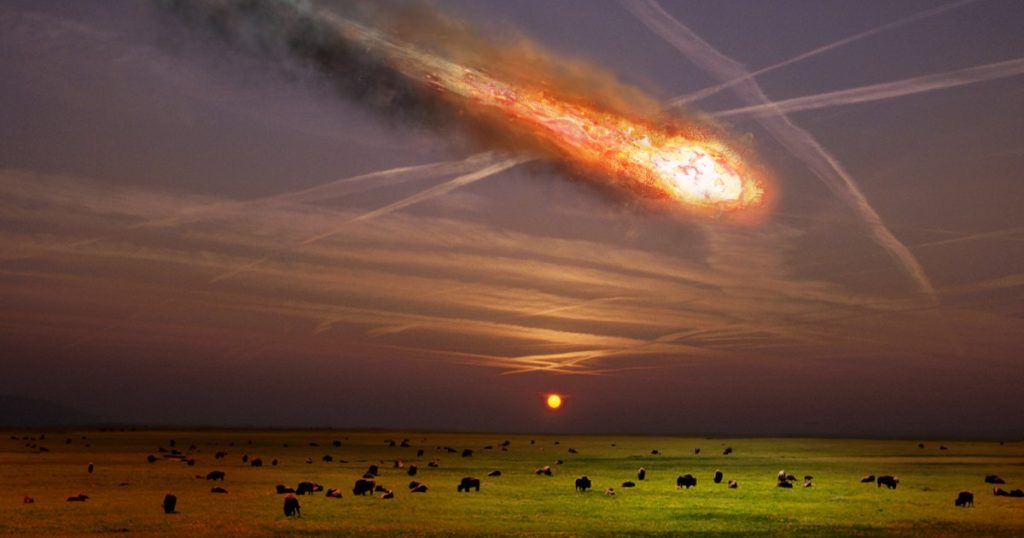Why ‘city-killer’ asteroid YR4’s impact probability keeps increasing – Big Think

On December 27, 2024, a very small, fast-moving asteroid was found in the vicinity of Earth. Dubbed 2024 YR4, or YR4 for short, it’s approximately 50 meters in diameter, weighs somewhere around 200,000 tons, and made its most recent, closest approach to Earth just two days prior: on December 25, 2024. In the time since its discovery, many observatories have monitored its motion, enabling us to reconstruct its orbit to a fairly good level of precision. We know it orbits the Sun with a period of around 4 years, achieving a maximum distance from the Sun of around 4.18 astronomical units, or right at the outer edge of the asteroid belt. It will make its next close approach to Earth (but will definitively miss us) on December 17, 2028, and then have a second, potentially hazardous encounter with us four years later: on December 22, 2032.The best data we have indicates that the asteroid will miss us in 2032 by a slim margin: just 160,000 kilometers, or less than half of the distance from the Earth to the Moon. However, our data is still highly uncertain, with a (99.7% confidence) region that spans 1.28 million kilometers across: a region that still definitively includes planet Earth, itself just ~12,750 km in diameter. Since its discovery, the reported odds of an impact with our planet have continued to increase: from 1.2%, initially, to 2.3%, then to 2.6%, and, as of February 18, now 3.1%.Does this mean we’re at a severe risk of an impact? Not at all. We can expect the probability to continue to increase for a time, and then, all at once, plummet to zero. Here’s the science of why that’s the most likely outcome, plus what humanity’s recourse should be if we get unlucky enough so that an impact becomes inevitable.What you see, above, is known as the Torino scale: the scale for measuring the potential hazards of an object in space that might strike the Earth. You’ll notice that the chart is divided up in a way that only some objects have any hazard rating at all. An object that will definitely miss us is Level 0; an object smaller than 20 meters in diameter is also Level 0, as even if it strikes us, the maximum amount of damage it could cause would be comparable to the Chelyabinsk impactor of 2013, which only resulted in minor injuries arising from broken glass that shattered during the asteroid’s impact.Larger bodies do pose a danger, with objects between 20-100 meters falling into the “city-killer” range, objects between 100 meters and 1 kilometer falling into the “regional devastation” category, and with objects greater than 1 kilometer representing an “extinction-level” threat. The greater the probability of impact, the higher the cause for alarm. However, even with all the recent attention given to asteroid YR4, it only ranks a “3” on this scale at present. According to NASA, an object with a Torino scale rating of 3 should be thought of as follows:“A close encounter, meriting attention by astronomers. Current calculations give a 1% or greater chance of collision capable of localized destruction. Most likely, new telescopic observations will lead to re-assignment to Level 0. Attention by public and by public officials is merited if the encounter is less than a decade away.”It’s no stretch to claim that YR4 is the most hazardous object yet identified since the invention of the Torino scale, and yet, it’s still very unlikely to pose any threat to Earth at all. NASA knows this, as you can see in its assertion that, “Most likely, new telescopic observations will lead to re-assignment to Level 0.” However, this both hasn’t been made clear in news reports and the reasons behind why this is the case are almost never discussed. Let’s fix that right now by going through the science of how we calculate orbital trajectories and, along with those calculations, estimate the uncertainties that come along with them.When you first identify an object through a telescope, there are a lot of things you can observe about it.The more observations you can take of the object — including with better tools, to greater precisions, and over longer baselines of time — the smaller your uncertainties will get, and the more confident you’ll be in your predictions for the object’s future trajectory. On the other hand, when you have fewer observations, including observations that are only acquired over a short period of time or a small fraction of the object’s orbit, your uncertainties will tend to be large.In general, the best time to observe an object, at least, if your goal is to fully determine its orbital trajectory, is when it’s moving rapidly across the sky: i.e., when it’s close to perihelion, or its closest approach to the Sun. For an object way out in the Kuiper belt, it might take several years of observations to determine a reliable orbit; for an object that’s much closer to us, such as in the inner Solar System, we can do much better with only a few weeks or a couple of months of observations.Because we only discovered 2024 YR4 in late December of 2024, well after its (November 22nd) perihelion, we’re only able to project its trajectory to within a specific precision at present. Although the best fit estimate to its trajectory indicates that it will miss Earth by ~160,000 km, there’s an uncertainty in that trajectory, primarily in one specific spatial dimension, of ±213,811 km.Think about what that means for a moment. It means that, based on what we know about this object, the best reconstructed orbital trajectory that we can infer for it implies that it will miss Earth by ~160,000 kilometers: about 12.5 Earth diameters. If we know this trajectory to a precision of ±10,000 km, then we could be completely certain it would miss us; it would take an outlier event of more than a 15-sigma (15 one-sided standard deviations) to lead to a collision, something with negligible (~0) probability.However, if we only knew this trajectory to a precision of ±40,000 km, we would think it’s likely that this object would miss us, but we’d want better data so that we could exclude a collision at higher significance. In physics and astronomy, that precision (of about 3.8-sigma) only excludes a collision at about the 99.98% level; we would like to be more precise.With today’s best data — that is, as of February 18, 2025 — our uncertainty on 2024 YR4 is unacceptably large, as this trajectory is only known to a precision of ±213,811 km. We’ll need, realistically, to determine its orbit to a precision that’s about seven times better in order to safely rule out the possibility of an impact.However, we’re in a lousy predicament right now, at least, in terms of the quality of the data we have. When it comes to statistical significance, anytime you see the “±” symbol, followed by a number, you need to ask yourself, “What type of uncertainty is this?” The uncertainty in the trajectory of 2024 YR4, as it’s being widely reported, is ±641,435 km, but that’s a 3-sigma uncertainty, not the standard 1-sigma that corresponds to ±213,811 km. The way statistics works, assuming your only measurement uncertainties are statistical in nature, tells us that:and so on.Because the most likely value is “only” 160,000 km away from Earth, that means that lowering the uncertainty to below its current value of ±213,811 km is going to:as we will then be able to predict its trajectory more robustly and with smaller errors.This has been precisely the scenario that’s arisen for practically every asteroid ever discovered and tracked, and is very, very likely (with still 96%+ probability) going to apply to 2024 YR4. The prior “record” for most likely terrestrial impact by an identified body went to asteroid Apophis, which was deemed to have a 2.7% chance of striking Earth back in 2004, when it was first discovered. Subsequent measurements better determined its trajectory, and its current risk of impact is deemed at odds much lower than 1-in-a-million. However, until we can reach that level of precision in our measurements for 2024 YR4 — which will likely require observations from the world’s most powerful telescopes, potentially including even JWST — we have to keep ourselves open to the possibility that it may yet strike us.That possibility makes measuring its trajectory (as well as its other properties) to an incredibly high precision all the more important. 2024 YR4, for example:That last uncertainty, arising largely from its uncertainty in overall mass (as we know it will move at around 17 km/s if it strikes Earth in 2032) is the difference between a Chelyabinsk-scale impact, which killed no one, and the type of impact that created Barringer Crater (also known as Meteor Crater) in Arizona, which could kill hundreds of thousands or more if it struck a large city.And there are, indeed, plenty of large cities in the potential path of 2024 YR4 that could experience dire consequences, including Bogotá, Columbia, Lagos, Nigeria, Sana’a, Yemen, Mumbai, India, and Dhaka, Bangladesh. Even in the event of an oceanic strike, the potential for coastal flooding and tsunami events means there are potentially billions or even trillions of dollars worth of property damage that could occur. If it were determined that 2024 YR4 was indeed at risk of striking Earth — something that should be easy to determine with high-quality data that ought to be acquired over the next few weeks and months — then our best recourse would be to leverage what we learned from the DART mission to redirect an asteroid, and get to work on planning for asteroid deflection of 2024 YR4.What would that look like?If you want to redirect a large, massive body in space, you need to course-correct as early as possible. When you’re on the highway and notice your vehicle slightly drifting toward one edge of your lane, you slightly adjust the steering wheel well ahead of time, otherwise you’ll be required to make a larger, more dynamic maneuver if you wait until the last minute. In the case of asteroid deflection, redirecting it would involve a blast or collision: imparting kinetic energy to it in an effort to change its motion. The longer you wait, and the closer the “redirect” time is to the impact time, the more energetic your efforts will need to be.There are a few things that determine how much energy you’d need to successfully redirect an asteroid like 2024 YR4. For one, you need to know how much time you have until impact, and for us, that’s until December 22, 2032. Our next best opportunity for redirection will occur about four years prior: on December 17, 2028, when 2024 YR4 makes another (relatively) close pass of Earth. Because Earth has a mean radius of 6371 km, we’ll need to deflect the asteroid by at least that much, and in order to change a massive object’s momentum, you need a massive (or energetic) impact to it that’s capable of sufficiently changing its motion, which depends on asteroid 2024 YR4’s overall mass.That last figure is greatly uncertain: it’s estimated at 220,000 tonnes (2.2 × 108 kg), but that’s uncertain by approximately a factor of 10. Missions like NASA’s DART or Deep Impact missions had masses of a few hundred kilograms, and can have relative speeds with respect to an asteroid that are significant: around ~10 km/s or potentially even a little more. If we’re generous, and assume:we could change the asteroid’s speed by about 18 centimeters-per-second. After four years, that could change the path of 2024 YR4 by up to 22,000 km: more than the full diameter of Earth.Yes, there would be potential risks if we did attempt to redirect the asteroid with an impact. The asteroid could fragment, leading to a long, distended trail of debris that struck Earth. The impactor could become embedded, nudging the asteroid but failing to cause it to miss Earth. Or we could choose a worse strategy than an impactor, such as detonating a nuclear device on or near the asteroid, which could simultaneously fail to sufficiently change its course while imparting it with radioactive, potentially deadly isotopes. The optimal strategy for redirection remains to impact the asteroid, in the proper direction, at the maximum speed with the maximum mass spacecraft with as much time in advance of the potential impact with Earth as possible.However, it’s unlikely that such a redirect mission will be required. Anything can pose a “risk of impact” if you’re bad enough at measuring it, and right now, the small, fast-moving nature of 2024 YR4 coupled with the brief window of observations we’ve acquired means that we’re sufficiently bad at measuring it that we do not know whether it will strike us or not. The odds are against it, but it will take better observations — observations which should be forthcoming — to know for sure. In all probability, the “odds of impact” will soon peak at around ~5%, and then plummet thereafter. But until we collect the critical data, we can’t know for sure. If we want to truly know what’s coming for us out there in the Universe, high-precision observations for the purpose of planetary defense are the most informative intervention we can take at present.
Source: https://bigthink.com/starts-with-a-bang/city-killer-asteroid-yr4-impact-probability/





